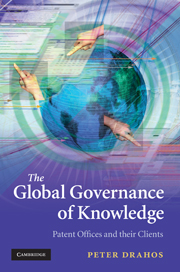Book contents
- Frontmatter
- Contents
- List of diagrams and tables
- List of abbreviations
- Preface
- 1 Patent offices and the global governance of knowledge
- 2 Labyrinths and catacombs: Patent office procedure
- 3 The rise of patent offices
- 4 The Sun and its planets: The European Patent Office and national offices
- 5 The USPTO and JPO
- 6 The age of Trilaterals and the spirit of cooperation
- 7 The jewel in the crown: India's Patent Office
- 8 The dragon and the tiger: China and South Korea
- 9 Joining the patent office conga line: Brazil
- 10 Islands and regions in the patent stream
- 11 Reclaiming the patent social contract
- 12 Patent administration sovereignty: Nodal solutions for small countries, developing countries
- Index
- References
3 - The rise of patent offices
Published online by Cambridge University Press: 03 May 2010
- Frontmatter
- Contents
- List of diagrams and tables
- List of abbreviations
- Preface
- 1 Patent offices and the global governance of knowledge
- 2 Labyrinths and catacombs: Patent office procedure
- 3 The rise of patent offices
- 4 The Sun and its planets: The European Patent Office and national offices
- 5 The USPTO and JPO
- 6 The age of Trilaterals and the spirit of cooperation
- 7 The jewel in the crown: India's Patent Office
- 8 The dragon and the tiger: China and South Korea
- 9 Joining the patent office conga line: Brazil
- 10 Islands and regions in the patent stream
- 11 Reclaiming the patent social contract
- 12 Patent administration sovereignty: Nodal solutions for small countries, developing countries
- Index
- References
Summary
Patent statutes
We know much more about the history of patent law than we do about the history of its administration. The emergence of patent law in statutory form is generally said to be 1474 when the Venetian Republic passed a short decree that gave ten years of protection to any person who built ‘any new and ingenious device in this City’. The other early major statutory landmark is the English Statute of Monopolies of 1624. This statute crystallized the pronouncements of the common law courts concerning the use by the English Crown of its prerogative power to grant monopolies in business. Monopolies in general were declared to be void, but an exception was made for patents and grants of privilege for ‘any manner of new manufactures within this realm’.
The spread through Europe of a patent institution based on legislation that gave inventors rights under law as opposed to having to depend on the exercise of prerogative was a slow process. In France public rights of inventorship are linked to laws adopted by the National Assembly in 1790 and enacted in 1791. After this there is something of a take-off in Europe of patent statutes: Austria 1810, Russia 1812, Prussia 1815, Belgium and the Netherlands 1817, Spain 1820, Bavaria 1825, Sweden 1834, Wurtemburg 1836, Portugal 1837, Saxonia, 1843.
Outside of Europe, the First Congress of the United States passed a patent statute in 1790.
- Type
- Chapter
- Information
- The Global Governance of KnowledgePatent Offices and their Clients, pp. 91 - 113Publisher: Cambridge University PressPrint publication year: 2010

